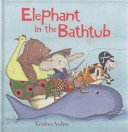
One day Elephant filled the bathtub with water and got in. There was still plenty of room, so Cat climbed in too. Then Baby Giraffe dropped in. Then Bear and Alligator and Cow … and . . .

One day Elephant filled the bathtub with water and got in. There was still plenty of room, so Cat climbed in too. Then Baby Giraffe dropped in. Then Bear and Alligator and Cow … and . . .

11-year-old Mackenzie has got one friend in the whole world: Cash, his brown-eyed pit bull. His dad won the runt after a long night of drinking and gambling–ever since Mac’s mom died, that’s all he seems to do, and soon he erupts in a rage at the innocent pup, takes her away in the trunk of his car, and dumps her in the middle of nowhere. Mac vows to find Cash and bring her back home–he has to: All strays are about to be outlawed! Little does he know that while he searches for Cash, she’s surviving her own adventures and proving in the process that all dogs–even pit bulls–are born good.
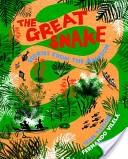
As the Rio Afuá ferry wends its way along the Amazon, Sean Taylor takes in not only the sights and sounds of this extraordinary landscape but also the stories of the people he meets. From sly jaguars and the slowest of sloths to spine-tingling giant serpents and white-suited strangers, his retellings teem with legendary beings, vivid color, earthy comedy, and the mysteries of the rainforest. Together, with Fernando Vilela’s dramatic, color-saturated illustrations, they reveal the Amazon peoples’ beliefs and way of life. Notes and a glossary provide additional information about the region.
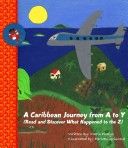
Join us in this fun and educational journey through the Caribbean islands, one letter at a time. From Aruba to Trinidad and from Alligator to Yam, you will learn the names of many of the islands, plus fascinating facts about them. A Caribbean astronaut? From which island? Seals in these tropical waters? An island with over 300 rivers? And what is a cok? With beautiful illustrations by Native American artist Earleen Griswold, drawn during her years living in the Virgin Islands, this is a book that you and your family will enjoy opening again and again. It will captivate, entertain, and educate readers from any part of the world. And wait until you see what they did with the Z.
Sophie’s brother has a mantel full of awards for his cute warts— verrugas—and shiny skin, but Sophie isn’t nearly as good looking and doesn’t have any trophies at all. One day, while Sophie is singing about her sorrows, the Toadettes are impressed and ask her to join their group. They convince her to do a solo at the fair when the rest of the group gets sick from eating bad flies. You can guess who finally gets a trophy of her own that night. Susan Elya’s seamless verse that includes Spanish vocabulary and Viviana Garofoli’s vivid, lively illustrations makes Sophie’s story one all kids will relate to while they search for their special talents.
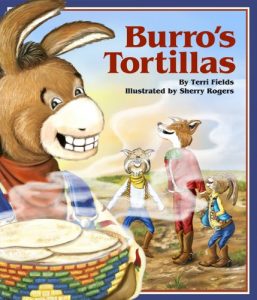 What do you get when you cross The Little Red Hen with a burro and his friends? Burro s Tortillas! In this humorous Southwestern retelling of a childhood favorite, Burro finds it difficult to get any help from his friends as he diligently works to turn corn into tortillas. Young children will love the repetition; older children will enjoy the book’s many puns. In addition to its Southwestern flavor, the delightful story imparts an accurate picture of the traditional way that tortillas are made. A Spanish/English glossary and a simple recipe for making tortillas are included in the For Creative Minds section.
What do you get when you cross The Little Red Hen with a burro and his friends? Burro s Tortillas! In this humorous Southwestern retelling of a childhood favorite, Burro finds it difficult to get any help from his friends as he diligently works to turn corn into tortillas. Young children will love the repetition; older children will enjoy the book’s many puns. In addition to its Southwestern flavor, the delightful story imparts an accurate picture of the traditional way that tortillas are made. A Spanish/English glossary and a simple recipe for making tortillas are included in the For Creative Minds section.
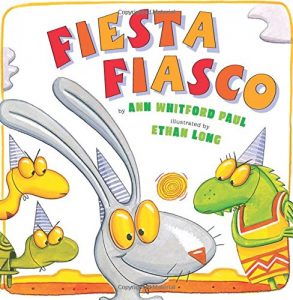 There is another desert party in the works in this spicy companion book to Mañana, Iguana. This time it is Snake’s birthday, and Iguana, Tortoise, and Rabbit are shopping for birthday gifts to bring to his fiesta. But what presents should they buy for Snake? In a sneaky twist, Rabbit convinces them to buy gifts that aren’t for Snake at all—but for him! With a clever text, a spattering of Spanish vocabulary. and lively illustrations, this author-illustrator team presents quite the fiesta fiasco. Glossary included.
There is another desert party in the works in this spicy companion book to Mañana, Iguana. This time it is Snake’s birthday, and Iguana, Tortoise, and Rabbit are shopping for birthday gifts to bring to his fiesta. But what presents should they buy for Snake? In a sneaky twist, Rabbit convinces them to buy gifts that aren’t for Snake at all—but for him! With a clever text, a spattering of Spanish vocabulary. and lively illustrations, this author-illustrator team presents quite the fiesta fiasco. Glossary included.
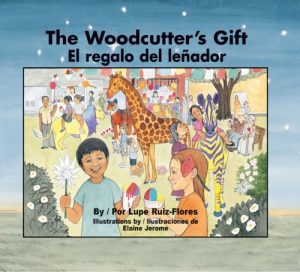 One day, a terrible thunderstorm knocked down the giant mesquite tree that grew in the town square. After the storm, the townspeople gathered to gawk at the large obstruction blocking the street. They weren’t sure what to do with it, but they all agreed that the wood was good for nothing except a fire. But the woodcutter Tomás sees something in the huge tree that the rest of the townsfolk don’t. “The beauty of this tree is not on the outside but on the inside,” Tomás tells them. In the following days, everyone watches curiously as the woodcutter carves and chips and whittles the wood into blocks. At one point, he moves the chunks into his shed, increasing everyone’s curiosity. What could the woodcutter be doing with all that lumber? Finally, Tomás calls the townsfolk together to see his creations: a wonderful collection of life-sized animals for the children to enjoy. Children and adults alike are thrilled with their private zoo! But a few weeks later the woodcutter is visited by strangers from a folk-art museum who want to buy the pieces for their collection. Will Tomás sell the town’s new zoo animals so that others can enjoy them too?
One day, a terrible thunderstorm knocked down the giant mesquite tree that grew in the town square. After the storm, the townspeople gathered to gawk at the large obstruction blocking the street. They weren’t sure what to do with it, but they all agreed that the wood was good for nothing except a fire. But the woodcutter Tomás sees something in the huge tree that the rest of the townsfolk don’t. “The beauty of this tree is not on the outside but on the inside,” Tomás tells them. In the following days, everyone watches curiously as the woodcutter carves and chips and whittles the wood into blocks. At one point, he moves the chunks into his shed, increasing everyone’s curiosity. What could the woodcutter be doing with all that lumber? Finally, Tomás calls the townsfolk together to see his creations: a wonderful collection of life-sized animals for the children to enjoy. Children and adults alike are thrilled with their private zoo! But a few weeks later the woodcutter is visited by strangers from a folk-art museum who want to buy the pieces for their collection. Will Tomás sell the town’s new zoo animals so that others can enjoy them too?
Illus: woodcuts
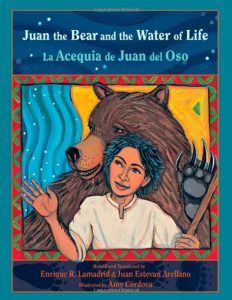 La Acequia del Rito y la Sierra in the Mora Valley is the highest and most famous traditional irrigation system in New Mexico. It carries water up and over a mountain ridge and across a sub-continental divide, from the tributaries of the RÃo Grande to the immense watershed of the Mora, Canadian, Arkansas, and Mississippi Rivers. The names and stories of those who created this acequia to sustain their communities have mostly been lost and replaced by myths and legends. Now, when children ask, some parents attribute the task of moving mountains and changing the course of rivers to Juan del Oso, the stouthearted man whose father was a bear.From the mountains of northern Spain to the Andes in South America, Spanish-speaking people have told ancient legends of Juan del Oso and his friends. In this children’s tale, agriculturalist Juan Estevan Arellano and folklorist Enrique Lamadrid share a unique version of a celebrated story that has been told in northern New Mexico for centuries.Reading level: age 10 years and up
La Acequia del Rito y la Sierra in the Mora Valley is the highest and most famous traditional irrigation system in New Mexico. It carries water up and over a mountain ridge and across a sub-continental divide, from the tributaries of the RÃo Grande to the immense watershed of the Mora, Canadian, Arkansas, and Mississippi Rivers. The names and stories of those who created this acequia to sustain their communities have mostly been lost and replaced by myths and legends. Now, when children ask, some parents attribute the task of moving mountains and changing the course of rivers to Juan del Oso, the stouthearted man whose father was a bear.From the mountains of northern Spain to the Andes in South America, Spanish-speaking people have told ancient legends of Juan del Oso and his friends. In this children’s tale, agriculturalist Juan Estevan Arellano and folklorist Enrique Lamadrid share a unique version of a celebrated story that has been told in northern New Mexico for centuries.Reading level: age 10 years and up